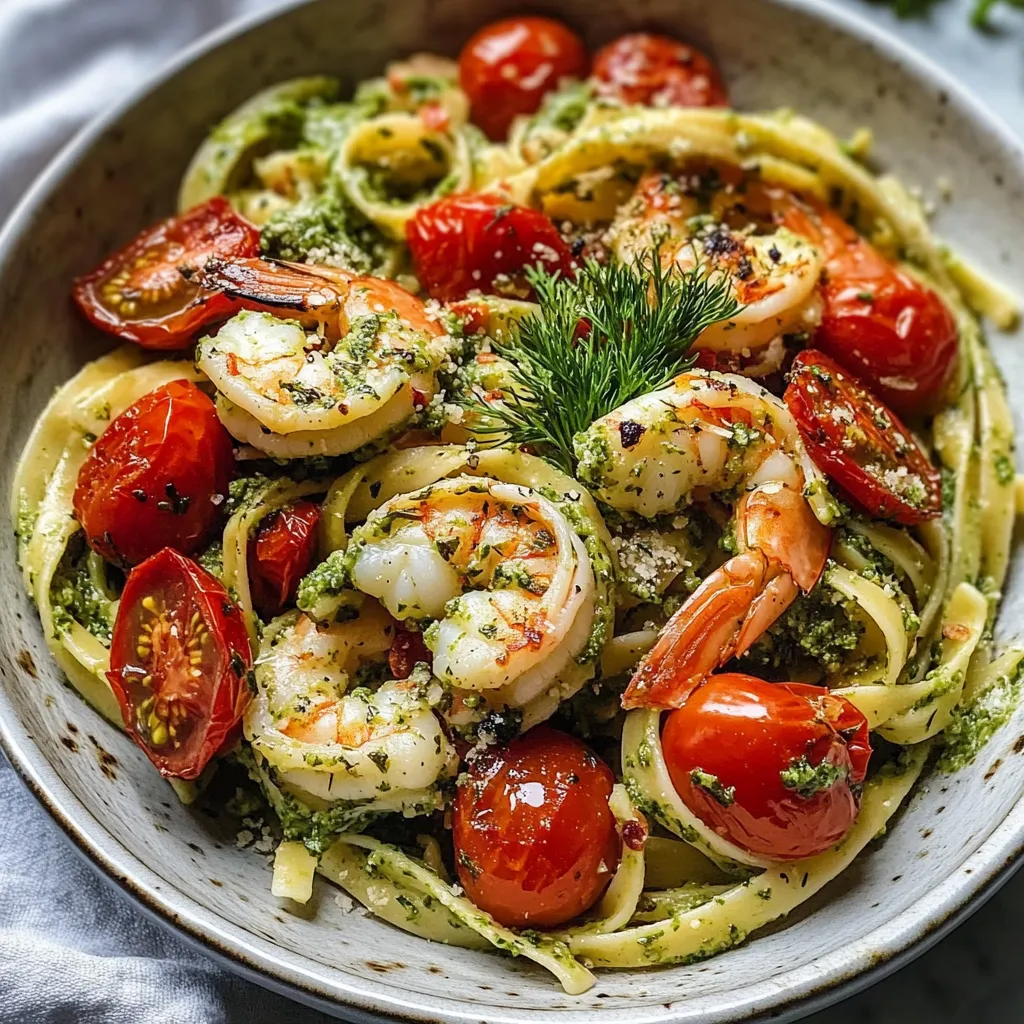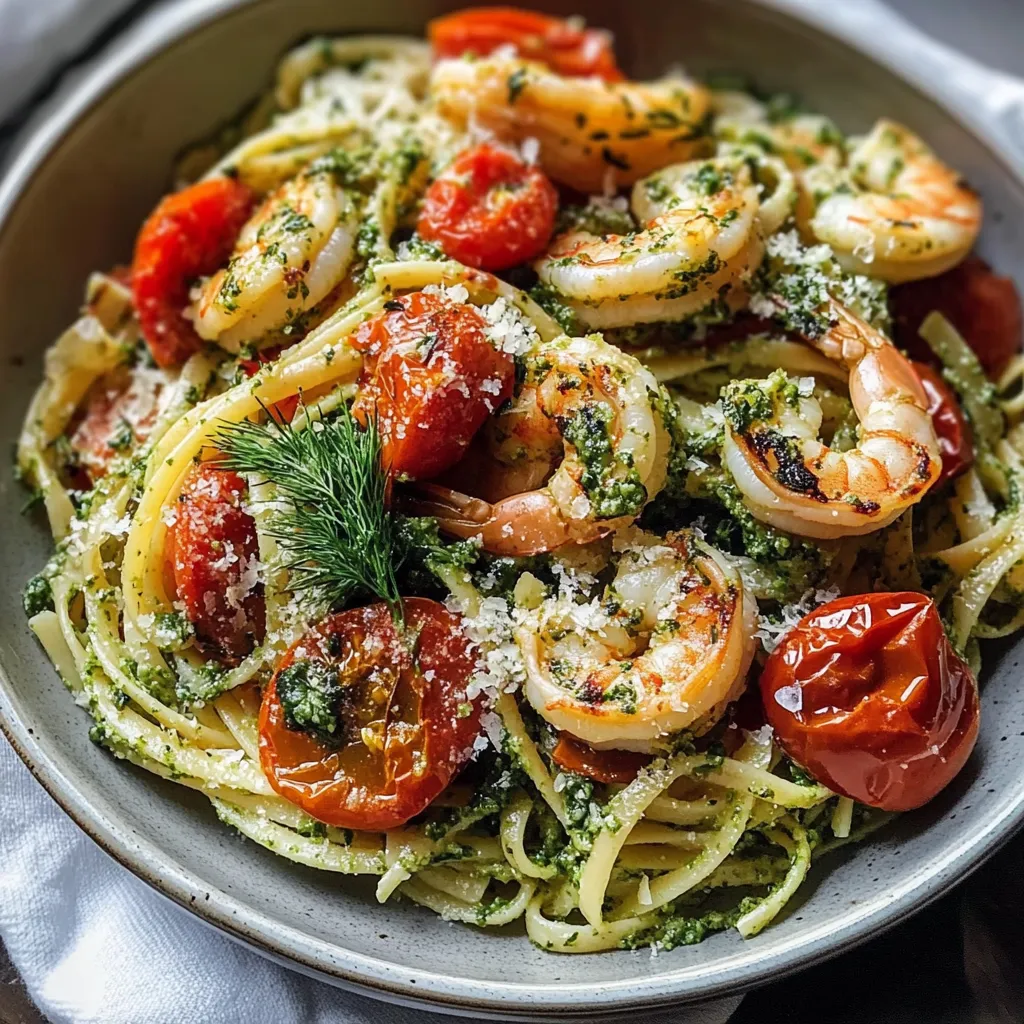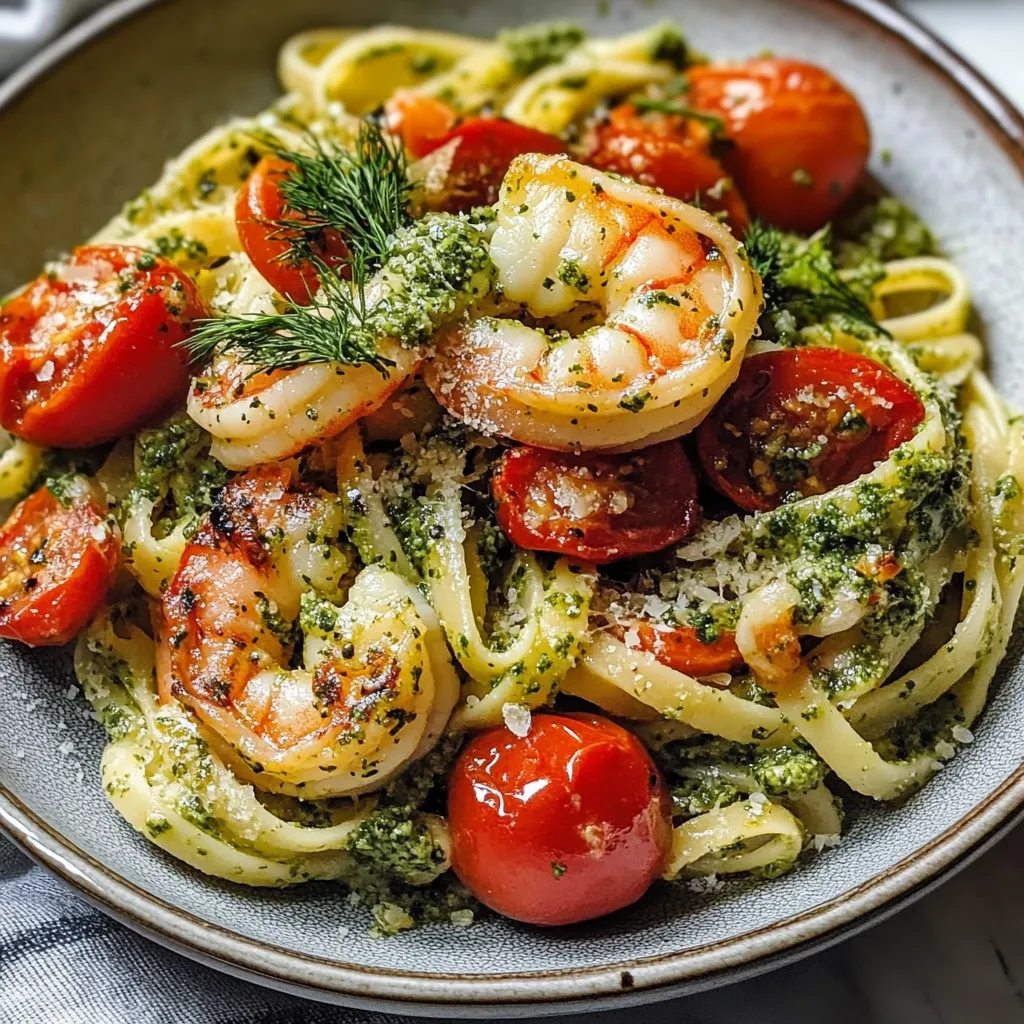 Pin
Pin
This hearty Shrimp Pasta with Dill Pesto and Garlic Roasted Tomatoes has become my springtime signature dish. The combination of herbaceous dill pesto, sweet roasted tomatoes, and lemony garlic shrimp creates a pasta that feels both comforting and refreshing.
I first created this pasta when I had an abundance of fresh dill in my garden. What started as a simple experiment has become the most requested dish when friends come over during spring and summer months.
Ingredients
- Fresh dill: offers a unique herbaceous flavor that makes this pesto stand out from traditional basil versions
- Pistachios: provide a buttery richness and slight sweetness that balances the brightness of the herbs
- Cherry tomatoes: roast down to develop intense sweetness while maintaining their juiciness
- Large shrimp: cook quickly and absorb the lemony garlic flavors perfectly
- Broccoli: adds texture, nutrition and a perfect vehicle for catching extra pesto
Step-by-Step Instructions
- Roast the tomatoes:
- Begin by heating your oven to 400°F. Arrange tomatoes and smashed garlic on a parchment-lined baking sheet, toss with olive oil, salt and pepper. Roast for about 20 minutes until the tomatoes burst, shrivel slightly and develop caramelized edges. The slow roasting concentrates their sweetness and creates a beautiful contrast to the bright pesto.
- Marinate the shrimp:
- While the tomatoes roast, place peeled shrimp in a bowl with lemon zest, finely chopped garlic, olive oil, salt and pepper. Let the shrimp absorb these flavors while you prepare the other components. This brief marination makes a huge difference in the final flavor.
- Create the dill pesto:
- Combine fresh dill, parsley, garlic, lemon zest and juice, pistachios, Parmesan, and seasonings in a food processor. Pulse until finely chopped, then stream in olive oil while processing until you achieve a smooth, vibrant green sauce. The combination of dill and pistachios creates a unique pesto unlike any other.
- Prepare pasta and broccoli:
- Boil your pasta in well-salted water until al dente. Meanwhile, sauté sliced garlic in olive oil until fragrant, then add broccoli florets. Cook until the broccoli reaches your desired tenderness and the garlic becomes golden and crisp. This step flavors the olive oil beautifully.
- Cook the shrimp:
- Just before serving, quickly cook the marinated shrimp in a hot skillet for about 2 minutes per side. Watch carefully as shrimp cook very quickly and overcooked shrimp become tough and rubbery.
- Assemble the dish:
- Toss hot pasta with dill pesto, ensuring every strand is coated. Fold in the roasted tomatoes, garlicky broccoli, and shrimp. The heat from the pasta will further release the aromatics in the pesto creating an intoxicating aroma.
 Pin
Pin
The dill pesto is truly the star of this dish. I discovered its magic when experimenting with herbs beyond the classic basil. The lemony brightness of dill creates a uniquely refreshing pesto that pairs perfectly with seafood and transforms an ordinary pasta into something memorable.
Storing Leftovers
If you plan to enjoy this pasta as leftovers, consider storing the components separately. Keep the pasta, pesto, vegetables and shrimp in different containers. When ready to eat, gently reheat the pasta with a splash of water before adding room temperature pesto and briefly warmed shrimp and vegetables. This prevents the shrimp from becoming overcooked and preserves the vibrant color of the pesto.
Perfect Substitutions
This recipe welcomes adaptations based on what you have available. For a vegetarian version, omit the shrimp entirely or replace with white beans or roasted chickpeas. The dill pesto works beautifully with salmon or chicken if you prefer those proteins. No dill? Try a combination of parsley and mint for a different but equally refreshing profile. The pistachios can be replaced with walnuts or pine nuts if needed.
 Pin
Pin
Serving Suggestions
Serve this pasta with a crisp white wine like Sauvignon Blanc or Pinot Grigio to complement the bright flavors. A simple green salad dressed with lemon vinaigrette makes a perfect accompaniment. For a complete spring meal, end with something light and citrusy like lemon sorbet or a fruit tart.
The Versatile Dill Pesto
Consider making a double batch of this unique dill pesto to use throughout the week. It makes a wonderful spread for sandwiches, a flavorful addition to scrambled eggs, or a dip for vegetables. You can also freeze it in ice cube trays then transfer to freezer bags for convenient portions that last up to two months.
Recipe FAQs
- → Can I make this pasta dish vegetarian?
Yes! You can easily make this dish vegetarian by omitting the shrimp and substituting white beans for protein. The dill pesto, roasted tomatoes, and sautéed broccoli provide plenty of flavor without the seafood component.
- → How long does the dill pesto stay fresh?
The dill pesto will keep in the refrigerator for up to 5 days when stored in an airtight container. You can also freeze it for up to 2 months. Consider making a double batch to have extra on hand for future meals.
- → What pasta shapes work best with this dish?
Ribbon-like pasta shapes work particularly well to capture the pesto and complement the other ingredients. Pappardelle, fettuccine, or mafaldine are excellent choices, but any pasta shape you prefer will work.
- → Can I substitute another herb for dill?
While dill gives this dish its distinctive flavor, you could substitute basil for a more traditional pesto or try a mix of fresh herbs like parsley, mint, and basil. Each variation will create a different but equally delicious flavor profile.
- → What can I serve with this pasta?
This pasta dish is quite complete on its own, but it pairs wonderfully with a simple green salad dressed with lemon vinaigrette or some crusty bread to soak up the extra pesto. A glass of crisp white wine like Pinot Grigio or Sauvignon Blanc complements the fresh flavors nicely.
- → Can I prepare any components ahead of time?
Yes! The dill pesto can be made 1-2 days in advance and stored in the refrigerator. The tomatoes can be roasted ahead of time and reheated before serving. The broccoli and shrimp are best prepared just before serving for optimal texture and flavor.
